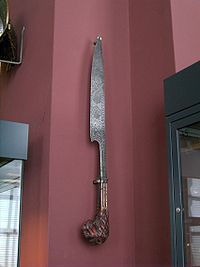Kuse
| Kuse | |
|---|---|

|
|
| Information | |
| Weapon type: | Polearm |
| Designations: | Couse |
| Use: | Weapon of war |
| Creation time: | approx. 14th century |
| Working time: | approx. 14th century - 20th century |
| Region of origin / author: |
Italy |
| Distribution: | Europe |
| Overall length: | approx. 140 cm - 250 cm |
| Handle: | Wood, leather, |
| Particularities: | different equipment and blade sizes |
| Lists on the subject | |
The kuse or breech knife is a European, medieval polearm that resembles the Guisarme , Glefe and the Japanese Naginata . However, it differs from the glaive in the lack of a spike on the back of the blade.
history
The name Kuse is derived from Kosa (scythe) and is related to the French word couteau (knife). The first, still very coarse, forms of the Kuse appear in Switzerland as early as the 14th century . It can be found in France at the beginning of the 15th century . It became so popular after the Battle of St. Jacob that the Swiss at the royal court were equipped with it.
In the 16th century , the kuse became the weapon of Philip I of Castile's life guard in Spain . Since then they have appeared at the Habsburg and several other German courts. The weapons collection of the imperial house in Vienna is kept by Kusen, which date from the time of Ferdinand I to Joseph II . The latter was the last emperor at whose court kusen were worn; the Bavarian Hartschiere wore the kuse in gala design until the end of the monarchy in the 20th century .
The more modern form of the Kuse originated in the 17th century at the Polish royal court and was used by Polish associations in the 18th century during the uprisings ( Kościuszko uprising ) after the partition of Poland.
description
The Kuse has a knife-shaped blade that is mounted on the shaft using a socket (socket) and is attached to the shaft with long shaft springs (two flat metal strips with screw or rivet holes). In some cases there is a metal disc on the shaft below the socket to protect the hand. Often a cross guard was attached to the back of the blade, which was intended to ward off sword blows. The shape of the kuse shows that it is suitable for cutting and less for stabbing.
As with the glaive, their shafts often reach a length of up to 2.50 meters. This unusual length has no fighting purpose. The average length was about 146 centimeters.
use
The kuse was designed to pierce the armor , especially the lentner , with heavy blows . Possibly it was also used to defend against opposing riders.
literature
- Wendelin Boeheim : Handbook of the armory . Leipzig 1890. Fourier Verlag, Wiesbaden. ISBN 3-921695-95-3 .
- Description in: Manuscripts of Jouvencel . 15th century, Paris National Library.